This page has been created simply to help people identify morphs/traits and even some colours. Should you have anything to add or any questions regarding morphs, please contact via PM.
You may find your crested gecko has several morph/traits, for example the crested gecko below is:
High % pinstripe (one pin missing), extreme tri-colour (I don’t normally mention these next two as most crested geckos display these traits) with kneecaps and fringing.
Fired Up & Fired Down
Before I get into the morphs/traits lets start off with fired up & fired down. Crested geckos can change their colour known as firing up and firing down.
When a crested gecko fires up it has an intense bright look, this usually occurs at night when they are active.
Usually a sleeping crested gecko is fired down and will change to a paler tone.
Firing up & down has many factors to it. This can depend on mood, time of day, environment, temperature, humidity, age, aggression and fear. Crested geckos often use it to aid camouflage, so don’t worry if a gecko never fires up or down, it doesn’t necessarily indicate that something is wrong or that it is stressed / upset. It could just be part of the crested geckos personality!
Sometimes you may find your crested gecko misfire, this is when the gecko is partly fired up and partly fired down. You may even see your gecko appear whiter than usual, this means they are likely to go into shed.
Fired Up
Fired Down
About To Shed
Misfire
Patternless
Patternless crested gecko is exactly that, a gecko that is one solid colour with no pattern.
Photo Credit (for both pics) To:
Elisha
Ghoulish Cresties
Bi-colour
Bi-colour is similar to a patternless but with a slightly darker or lighter colour along the dorsal.
Tiger
A tiger crested gecko will have a lighter base colour with darker lines that run almost vertical from the dorsal down the laterals.
Brindle
Brindle crested geckos are similar to tigers except the lines are broken with a more marbled / sporadic effect.
Flame
Flame crested geckos will have a base colour with a lighter colour along the dorsal. Flames will show little to no pattern on their laterals or limbs.

Photo Credit To:
Elisha
Ghoulish Cresties
Harlequin
Harlequin crested geckos are like flames, but with more pattern. Harlequins will show pattern along the lower laterals and limbs.
Extreme Harlequin
Extreme harlequin crested geckos are similar to harlequin crested geckos but with more pattern along the upper laterals, covering approximately 80%. Patterns seen on extreme harlequins can also connect the dorsal pattern to the upper lateral pattern.
Photo Credit To:
Michelle
FoxReptiles
Photo Credit To:
Elisha
Ghoulish Cresties
Pinstripe
A pinstripe consists of full raised scales along the edge of the dorsal. The rest of the geckos dorsal can have flame / harlequin patterning, or it can be solid cream to match the pinstripe.
Partial Pinstripe
If the pinstripe is broken and forms no more than 90% of the dorsal edge, it would be a partial pinstripe
Pin Dash
If a pinstripe has relatively large broken gaps along the dorsal, it would be a pin dash.
High % Pinstripe
If the pinstripe is slightly broken along the dorsal and between 90-99%, it would be a high % pinstripe
Reverse Pinstripe
A reverse pinstripe is a dark stripe underneath the dorsal scales where a pinstripe would be.
Photo Credit To:
Elisha
Ghoulish Cresties
Phantom Pinstripe
A phantom pinstripe will usually have muted colours on the dorsal and lateral area as well as a darker row of scales where a pinstripe would be. Phantom pinstripe can be full, partial, or dashed and are often seen on geckos with the reverse trait.
Photo Credit To:
Elisha
Ghoulish Cresties
Quadstripe
Quadstripes will have the pinstripe pattern/structure, with the addition of two well defined lines along the middle of the lateral area. The lateral stripes should span the majority of the area between the front and back limbs as a continuous line.

Photo Credit To:
Elisha
Ghoulish Cresties
Photo Credit To:
Michelle
FoxReptiles
Phantom Quadstripe
Phantom quadstripes will have the muted colours on the dorsal while displaying the darker row of scales along the dorsal edge as well as the defined lines along the middle of the lateral area.
Photo Credit To:
Elisha
Ghoulish Cresties
Super Stripe
A super stripe crested gecko will have a cream line along the middle of the laterals, this does not have to be a full line to qualify. This gecko will have a thick stripe like pattern along the middle of the dorsal, this will usually match the base colour, while the dorsal edge will remain cream. The pinstripe can be full or pin dashed
Dalmation
Dalmatian are spots that can be seen on any crested gecko regardless of other morph / traits. If a crested gecko with as little as one spot is bred, it is highly likely the spots will be passed to the offspring.
Spots can vary in size and colour, with black spots being the most common, however red and orange spots can appear as well.
Dalmatians are defined by at least 25 black spots varying in size that are dispersed across the crested gecko. Hatchlings do not always show many spots at young ages, this may develop with age depending on lineage.
Photo Credit To:
asher199212
Dal Spots
A few spots here and there do not justify as a dalmatian, but are referred to as dal spots.
Ink Blot / Ink Spots
Some dalmatians display spots larger than normal these are ink blot / ink spots. Ink blot / ink spots show at least a handful of large spots and can have an irregular shape.
Photo Credit To:
Riley
erie-herps
Super Dalmatian
Super Dalmatian is a dalmatian morph containing an abundance of spots across the entire body. They would require a minimum of 100 spots to qualify. Good luck counting!
Photo Credit (for both pics) To:
Elisha
Ghoulish Cresties
Confetti
Confetti dalmatians have black, red and orange spots. All three must be present to qualify.
Halloween
Halloween crested geckos are harlequins with black and orange markings. Yellow, gold and cream colouring will not be visible on this gecko, this includes the geckos tail.
Lavender
This is trait is referring to the base colour of the crested gecko. When the gecko is fired down, the base colour will have a light grey colouring. When fired up, the base colour will be ever so slightly darker than it’s fired down phase which will show a slight blue / purple hue.
Photo Credit (both pics) To:
Elisha
Ghoulish Cresties
Photo Credit To:
Michelle
FoxReptiles
Tricolour
Tricolour crested geckos show three distinct colours that are displayed on the laterals, these colours must be equally shown to qualify, this includes the base colour. White spots, portholes and quadstripes are not included as one of the distinctive colours as they are separate traits. The Dorsal is also not considered as part of the Tricolour. The Dorsal will be like a Harlequin or Extreme.
Photo Credit To:
Michelle
FoxReptiles
Photo Credit To:
Elisha
Ghoulish Cresties
Extreme Tricolour
Extreme tricolour is a gecko formed of an extreme harlequin and a tricolour. So the gecko would display the three colours along the laterals, however the patterning would cover approximately 80% of the upper laterals, leaving minimal visible base colour.
Photo Credit To:
Ghoulish Cresties
Photo Credit To:
Michelle
FoxReptiles
White Wall
White wall crested geckos have a solid block of white/cream on the lower lateral. The white / cream should be un-broken with a distinct line separating it from the base.
Furry
This refers to the raised scales along the edges of the dorsal area. A pinstripe crested gecko has a uniform line of raised scales around the edge, whereas furry crested geckos will have similarly raised scales but in a more sporadic arrangement. The crest tips are noticeably different, usually thicker and longer than that of a crested gecko without the furry trait.
Photo Credit To:
Elisha
Ghoulish Cresties
Portholes
Portholes are raised (compared to the rest of the laterals) off-white/cream scales usually found along the laterals. They range in size, shape and quantity. White portholes are not part of the dalmatian, snowflake or tricolour trait. This trait is due to pigmentation being unable to form while the gecko is in the egg.
Snowflake
The snowflake effect is when a gecko displays white spots along the lateral and limbs. It can be visible from a young age or it may not be present when geckos are young, this trait improves as the gecko grows. This is usually associated with the lighter dorsal (harlequins, extreme harlequins, tricolours, phantoms & lilly whites).
Kneecaps
This is when the the front part of the back limbs show an off-white/cream colour that is different to the base colour. This can be a small line or it can reach down to the toes. This is present in most crested geckos.
Drippy
This is when the Dorsal colour comes down from dorsal on to the upper laterals. The Lighter dorsal is a key component in drippy trait (harlequins, extreme harlequins, tricolours & lilly whites).
Photo Credit To:
Michelle
FoxReptiles
Photo Credit To:
Elisha
Ghoulish Cresties
Crowned
This term is in reference to the head shape of the crested gecko, specifically its width. It is said that the head length will be 1.3 times less the head width. I’m not sure I would be comfortable measuring a crested geckos head, so I would suggest that if the length is short and the width is wide, then it is crowned. It is unlikely that this will be evident in young geckos, but will be noticeable when the gecko is an adult.
Floppy Crests
Floppy crest refers to when the crested geckos head is very wide and the crests are very thick, so much so that they droop down to the sides of the geckos face.
Photo Credit To:
Michelle
FoxReptiles
Photo Credit To:
Ghoulish Cresties
Frogbut / Tailless
This term is in reference to a crested gecko that has dropped its tail. Crested geckos do not have the ability to regenerate their tails. If a crested gecko drops it’s tail, it is gone forever.
Photo Credit To:
Elisha
Ghoulish Cresties
Fringing
Fringing is when the scales along the back side of the hind limbs are off-white/cream. This can sometimes reach the feet. This is present in most crested geckos
White Tip / Orange Tip
This refers to the colour of the crests on the crested gecko. Often, the crest colour will be the same colour as the overall head. When the crest colour is different from the overall head colour, it is called “tip”. The most common “tipped” colours are off-white or orange. Sometimes all of the crest will “tip” in either off-white / white or orange, and sometimes just a few of the scales will display the off-white / white or orange.
Eyelash Effect
This isn’t a well known trait. Eyelash effect is when the crested geckos eyelashes are a different colour to that of the overall head.
Soft Scale
The Soft Scale project originated with AC Reptiles. Soft Scale is different, but difficult to detect without close examination. It appears these geckos exhibit fewer bumps or scales on their skin than most non soft scale geckos, leaving more space between them, giving a soft feel to the gecko. The colour is enhanced, cleaned up and visually brighter than what you would see on a non soft scale crested gecko. Soft scale crested geckos have a dark grey or black ring around the edge of the exposed part of the eyeball. Soft scales often have a steely grey eye colour.
The best way to tell if you have a soft scale crested gecko, is to breed it to another soft scale crested gecko. This will then produce an approximate ratio of 25% super soft, 50% soft scale and 25% non soft.
Soft scale crested geckos are quite new/rare to the public so please do your research and beware of anyone selling this label, as it’s not likely there are many actively breeding.
Photo Credit To:
Michelle
FoxReptiles



Photo Credit To:
Lil Monsters
Lil Monsters
Lilly White
A lilly white crested gecko is a high white crested gecko. The tail will be solid white from the base to the tip with no breakage when looking at the tail from a top view and the eyes will be a silvery grey colour. Baby lilly white crested geckos are likely to appear less white along the dorsal and laterals with a yellowish or orange colour that fades with age, however the they should still have a solid white tail. The underneath of the tail can show pattern and colour but it will not cross over to the top half of the tail. The tip of the tail may have a slightly different colour or even slight grey colouring but it will not create a pattern that you see in non-lilly white geckos.
Lilly white crested geckos will have white/cream colouring along the belly. You will be able to see the white/cream colouring from underneath your gecko up to the lower laterals. This is likely to spread as the gecko ages. The white/creamy colour along the lower lateral with show slightly raised compared to the base of the gecko…
You will notice that the Lilly White crested geckos skin is a softer with a more velvet like feel to the touch than most non-lilly white geckos.
Lilly whites geckos are not usually bred to other lilly whites geckos due to high fatality in the off-spring. However, pairing a lilly white to a non-lilly white gecko should result in lilly white and non lilly white offspring.
Phantom Lilly White
A Phantom Lilly White will have the typical phantom markings along the dorsal with a patternless or bi-colour effect, however the dorsal may also show slight white/cream colouring. They are likely to have a solid white tail with some blemishes and a slight breakage at the base of the tail.
The lower lateral will have the raised white/cream colouring similar to Lilly White.
Photo Credit (both pics) To:
Elisha
Ghoulish Cresties
Axanthic
Axanthic is a crested gecko that is unable to create yellow pigment. Yellow pigment usually makes the tails of a gecko cream colour. Geckos such as this display only black, blue, white, grey and silver colouring.
Photo Credit will be given, unless stated then photo credit belongs to creator of topic:
Michelle
FoxReptiles
















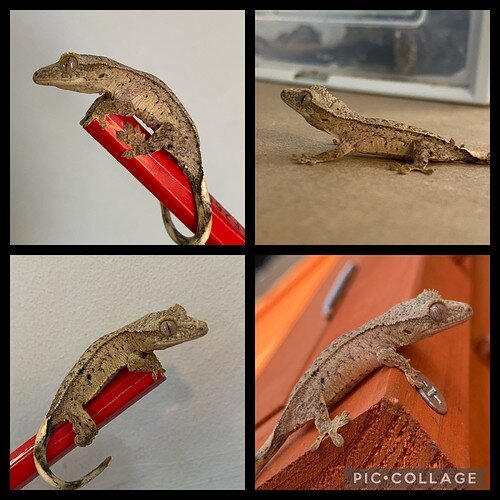





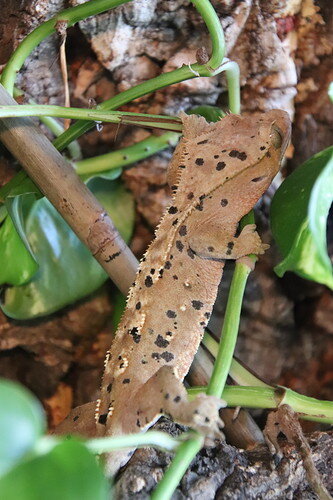

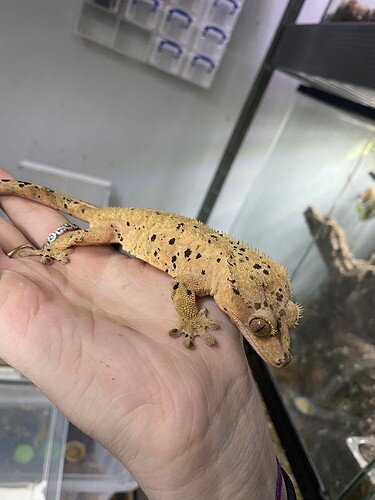



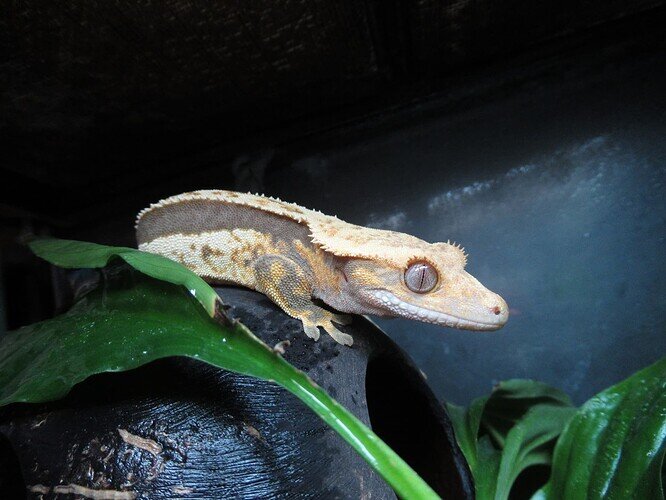






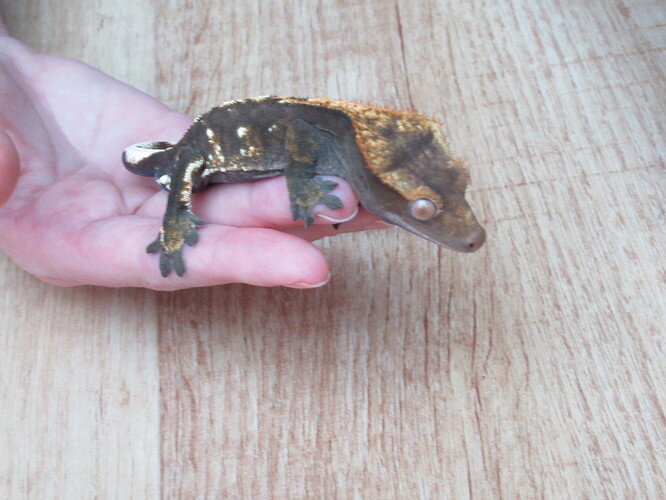







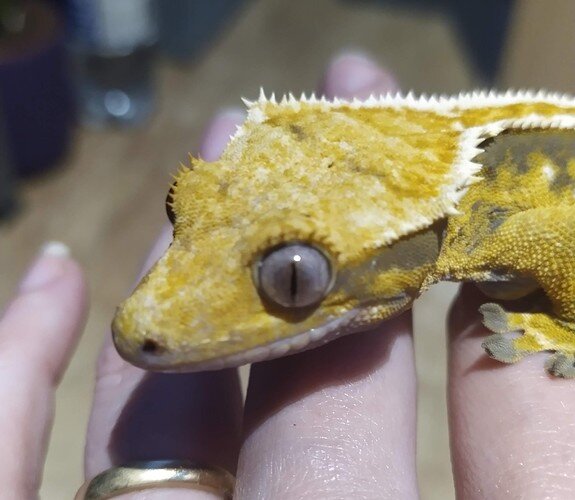



















 Can’t wait til finished.
Can’t wait til finished.